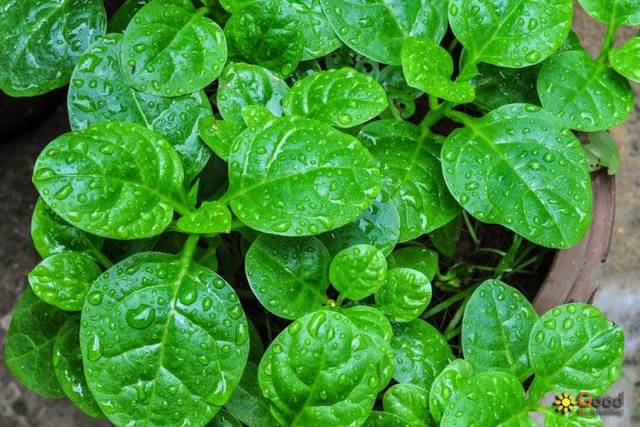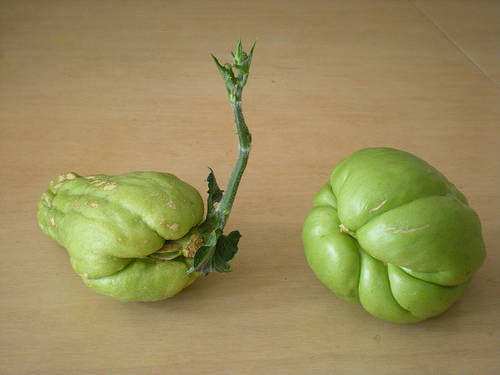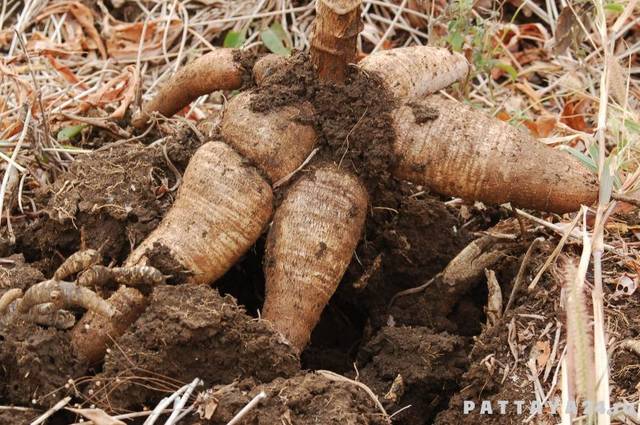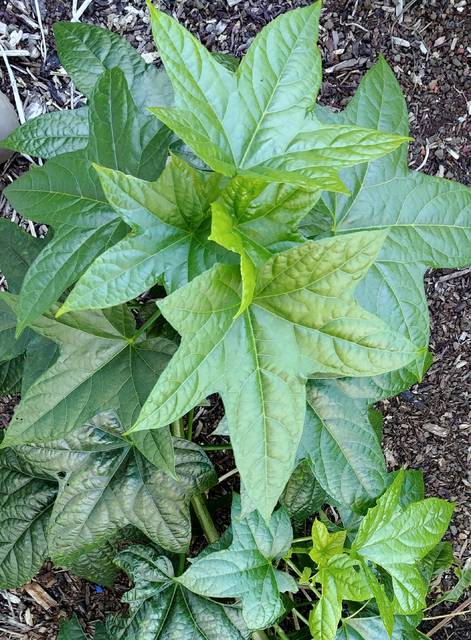Plant(s) of the month: Perennial vegetables that grow well in Kona

The round leaves of the Malabar spinach vine are an attractive addition to any garden. (Wikipedia.com via Diana Duff/Special to West Hawaii Today)

The chayote squash vine produces lots of tasty squash and replants itself with shoots from the mature fruit. (Picquery.com via Diana Duff/Special to West Hawaii Today)

The roots of the cassava plant are an important food source in many tropical countries. (Plantsinusa.com via Diana Duff/Special to West Hawaii Today)

The large, soft green leaves of the edible hibiscus shrub can be eaten raw or cooked. (Diana Duff/Special to West Hawaii Today)
After several requests for advice on perennial vegetables that grow well in Kona, here are some of my favorites. Consider growing them as attractive ongoing edibles for your garden.
After several requests for advice on perennial vegetables that grow well in Kona, here are some of my favorites. Consider growing them as attractive ongoing edibles for your garden.
The word perennial means long-lasting. When applied to vegetables it usually means plants that produce edible crops continually. Here in Hawaii, many plants that die back in winter in temperate climates continue growing and producing here. Good examples of these are herbs, many bean varieties and nightshades like tomatoes, peppers, eggplant and okra as well as greens like kales and mustards. All of these grow well here and will continue through many seasons, but if you want to grow some truly tropical perennial vegetables try some of these:
Chaya or tree spinach (Cnidoscolus aconitifolius) is a fast-growing shrub that probably originated in Mexico with large deeply cut three- or five-lobed leaves. It is a popular leaf vegetable in many tropical locales, eaten like spinach but usually cooked. It can grow to be more than 10 feet, but is best pruned short for easier harvest. The leaves should be cooked for 5 to 15 minutes to break down the acid in them. Chaya grows well from cuttings.
Abelmoschus manihot is an edible hibiscus in the Mallow family. It has an attractive yellow flower that resembles a hibiscus. The shrub can reach 10 feet, but responds well to pruning to keep it low. The leaves are a nutritious vegetable high in vitamins, iron and protein. Leaves can be harvested year-round and new plants can be easily propagated from cuttings or from the seeds in pods that follow flowering. It is disease resistant and considered to be of medicinal value.
Malabar spinach (Basella alba) is a perennial vine with small round edible leaves. It is found in tropical Asia and Africa, where the leaves are widely used as a vegetable. It grows well in full sun in hot, humid areas at lower elevations. It prefers sandy loam soils that are rich in organic matter. The leaves contain a mucilage that breaks down with cooking.
Two varieties of Okinawan spinach (Gynura crepioides) grow well here. One has green leaves, the other has leaves that are green on top and purple underneath. Both varieties make an excellent ground cover and can quickly cover an area in full sun. Both kinds can be eaten either raw in salads or cooked. In their native China, they are considered medicinal vegetables.
Another great edible ground cover is the sweet potato, Ipomoea batatas. Both the young leaves and tubers are edible. Particularly popular here is the purple-fleshed tuber that is grown commercially on Molokai. You can harvest the leaves year-round and grow more plants from cuttings at any time or after harvesting the tubers. Bake them or put them in stews with coconut milk for a delicious tropical treat.
The yam bean (Pachyrrhizus erosus) is neither a yam nor a bean. Known to us as jicama, the plant is a Central American native. Once the underground tubers are harvested, you can peel off the thin skin to reveal its crisp white flesh. It can be eaten sliced or grated raw or cooked in a stew. Raw, it has a flavor somewhere between an apple and a potato.
Winged bean (Psophocarpus tetragonobolus) is a tropical bush bean that grows well here. We can grow many temperate bean varieties but this one has a unique triangular shape with fringy edges. The young pods are tasty cut into stir fried dishes or simply steamed whole. The plant is a prolific producer and can be regrown from seeds collected from mature dry pods.
Chayote squash (Sechium edule) grows best as a climbing vine on walls or fences. This is the best summer type squash to grow here as summer squashes and zucchinis are vulnerable to the pickle worm and other pests. Chayote has a neutral flavor like zucchini, which makes it very versatile as a culinary vegetable. As they mature the squashes will put out a shoot from the base that can be used to start a new plant. Check online for lots of chayote recipes.
Cassava (Manihot esculenta) is known to us as tapioca since tapioca pearls are made from its starchy roots. It is an attractive woody shrub that grows easily in any soil, and is quite drought-tolerant. It is native to Central and South America and grown extensively throughout the tropics for its tuberous roots. Both the leaves and roots are edible but both need to be cooked to break down toxic acids. It grows well from cuttings so you can keep several going and harvest the older ones.
Taro (Colocasia esculenta) was brought to Hawaii as a staple by the early Polynesian settlers. Leaves can be cooked to get rid of acid and the roots are eaten like a potato once cooked to break down the oxilates. “Celery stem” taro leaves are edible without cooking. Taro’s large heart shaped leaves make an attractive addition to a garden. Taro can be prepared in many ways including mashed and fermented as poi. Once the underground corms are harvested, the “huli” (the top of the root and the lower stem) can be replanted to keep the crop in production.
Some of these plants may be hard to find in local nurseries, but call round to see or look for people who have them growing. They are all easy to propagate from seeds or cuttings.
To learn more about these and other tropical edibles check out the Growing Your Greens YouTube where John goes on a field trip to the Tropical Edibles Nursery. See it at https://www.youtube.com/watch?v=cNYS_O-nbPY.
Diana Duff is a plant adviser, educator and consultant living on an organic farm in Captain Cook.
Gardening Events
Friday: “Tree Climbing Workshop,” 8 a.m to 3:30 p.m. at Alae Cemetery, 1033 Hawaii Belt Road in Hilo. Aloha Arborist Association sponsoring the workshop for landscapers, arborists and tree workers. 6.5 CEU are available to attendees. $75 to AAA members. Lunch included. Info/register: Visit https://alohaarborist.com/index.php/tree-climbing-workshop-6-5-ceus-to-be-held-in-hilo-2-9-2018.
Saturday: “Work Day at Amy Greenwell Garden,” 9 a.m. to 12:30 p.m. Meet at the Garden Visitor Center across from The Manago Hotel in Captain Cook. Volunteers will be able to help with garden maintenance and are invited to bring a brownbag lunch. Water and snacks provided. Info: Call Peter at 323-3318.
Farmer Direct Markets
Wednesday: “Sunset Farmers Market,” 2 to 6 p.m. in the HPM parking lot at 74-5511 Luhia St. in Kailua-Kona (across from Target)
Wednesday &Friday: “Hooulu Farmers Market,” 9 a.m. to 2 p.m. at Sheraton Kona Resort &Spa at Keauhou Bay
Friday: “Pure Kona Market,” 9 a.m. to 5 p.m. at Amy Greenwell Garden in Captain Cook
Saturday: “Keauhou Farmers Market,” 8 a.m. to noon at Keauhou Shopping Center
“Kamuela Farmer’s Market,” 7 a.m. to noon at Pukalani Stables
“Waimea Town Market,” 7:30 a.m. to noon in front of Parker School
“Waimea Homestead Market,” 7 a.m. to noon at the Waimea Middle and Elementary School Playground
Sunday: “Pure Kona Green Market,” 9 a.m. to 2 p.m. at Amy B.H. Greenwell Garden in Captain Cook
Plant Advice Lines
Anytime: konamg@ctahr.hawaii.edu
Tuesdays &Thursdays: 9 a.m. to noon at UH-CES in Kainaliu – 322-4892
Monday, Tuesday &Friday: 9 a.m. to noon at UH CES at Komohana in Hilo 981-5199 or himga@hawaii.edu


